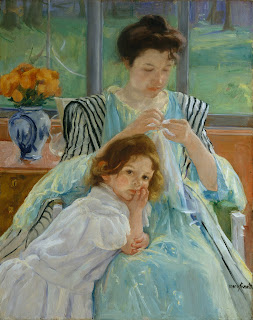- Why is this house called Fallingwater? The house extends over a waterfall.
- Which exterior materials on this house are natural and which are man-made? The stone is natural, and the concrete, glass, and metal are man-made.
- Notice how the textures of these materials contrast with each other. Describe the textures of the different parts of the house. The glass is smooth and shiny and the rock is very rough. The concrete is gritty, but not as rough as the stone, nor as smooth as the glass.
- How did Wright preserve the natural beauty of this site? He made the house blend into the natural landscape by echoing the shape of the cliff and boulders. He built a large portion of the house from rock quarried on site. He did not plant large expanses of lawn, bulldoze the site to make it level, or cut down many trees.
- What parts of Fallingwater are cantilevered? The horizontal balconies are cantilevered.
- What part of the building appears to create the weight to hold them in place? The vertical stone column fulfills this function.
- Why might a city dweller enjoy this house? Imagine being on one of the balconies. What would you hear?
A retreat in the country would be a change of scenery for those who live in a city. From the balcony you hear the sound of the waterfall.
- The Kaufmanns wanted a vacation home on their land. Why was the location that Wright chose for the house a surprise to them? Where would most architects probably have located the house to take advantage of the natural waterfall? Most architects would locate the house to have a view of the waterfall instead of placing the house on top of it.
- How is Fallingwater like a piece of contemporary abstract art from the twentieth century? It’s been simplified into basic, essential shapes without added ornamentation.
The Guggenheim Museum in New York City


La Miniatura - Most people do not know that the famous architect, Frank Lloyd Wright, was commissioned to design and construct a home that resembles a “Mayan temple set in a jungle ravine”. Even more extraordinary is that it still stands in Pasadena, California. Frank Lloyd Wright enjoyed creating “La Miniatura” so much, he was quoted as saying, “I would rather have built this little house than St. Peter’s in Rome.”

E. Fay Jones 1921-2004
 Euine Fay Jones was probably Frank Lloyd Wright’s most famous apprentice. Jones and Wright had an immediate rapport when they met while Jones was a professor. Jones’s entire family visited Wright in his winter workshop, Taliesin West, near Scottsdale, Arizona. Later, Wright invited Jones's entire family to his home and design institute Taliesin in Spring Green, Wisconsin. Jones returned to both sites numerous times as both friend and apprentice and became a Taliesin Fellow.
Euine Fay Jones was probably Frank Lloyd Wright’s most famous apprentice. Jones and Wright had an immediate rapport when they met while Jones was a professor. Jones’s entire family visited Wright in his winter workshop, Taliesin West, near Scottsdale, Arizona. Later, Wright invited Jones's entire family to his home and design institute Taliesin in Spring Green, Wisconsin. Jones returned to both sites numerous times as both friend and apprentice and became a Taliesin Fellow.A quiet, unassuming intellectual (also a strong Christian!) who taught Architecture at the University of Arkansas in Fayetteville, Jones’ most well-known buildings are chapels and residences in his home state (as opposed to ego-driven skyscrapers). Thorncrown Chapel, a small, breathtaking glass chapel nestled in the Ozarks, pays tribute to the beauty of nature created by God.
(Top to bottom: Cooper Chapel, Pinecone Pavilion, Spock at the Ministry...aka Skyrose...in the new Star Trek movie, Thorncrown Chapel)




















 Young Mother Sewing, 1900; Oil on canvas; 36 3/8 x 29 in. (92.4 x 73.7 cm)During the 1890s Cassatt narrowed the range of her subjects to mothers or nurses caring for children, and children alone. These themes reflected her affection for her nieces and nephews and her friends' children as well as her contemporaries' concern with motherhood and child rearing. Set in the conservatory of Cassatt's seventeenth-century manor house near Le Mesnil-Théribus, Oise, this painting depicts two of her favorite unrelated models in the roles of mother and child. Louisine Havemeyer, who purchased the painting in 1901, remarked on the truthfulness of its narrative: "Look at that little child that has just thrown herself against her mother's knee, regardless of the result and oblivious to the fact that she could disturb ‘her mamma.' And she is quite right . . . Mamma simply draws back a bit and continues to sew."
Young Mother Sewing, 1900; Oil on canvas; 36 3/8 x 29 in. (92.4 x 73.7 cm)During the 1890s Cassatt narrowed the range of her subjects to mothers or nurses caring for children, and children alone. These themes reflected her affection for her nieces and nephews and her friends' children as well as her contemporaries' concern with motherhood and child rearing. Set in the conservatory of Cassatt's seventeenth-century manor house near Le Mesnil-Théribus, Oise, this painting depicts two of her favorite unrelated models in the roles of mother and child. Louisine Havemeyer, who purchased the painting in 1901, remarked on the truthfulness of its narrative: "Look at that little child that has just thrown herself against her mother's knee, regardless of the result and oblivious to the fact that she could disturb ‘her mamma.' And she is quite right . . . Mamma simply draws back a bit and continues to sew."

















